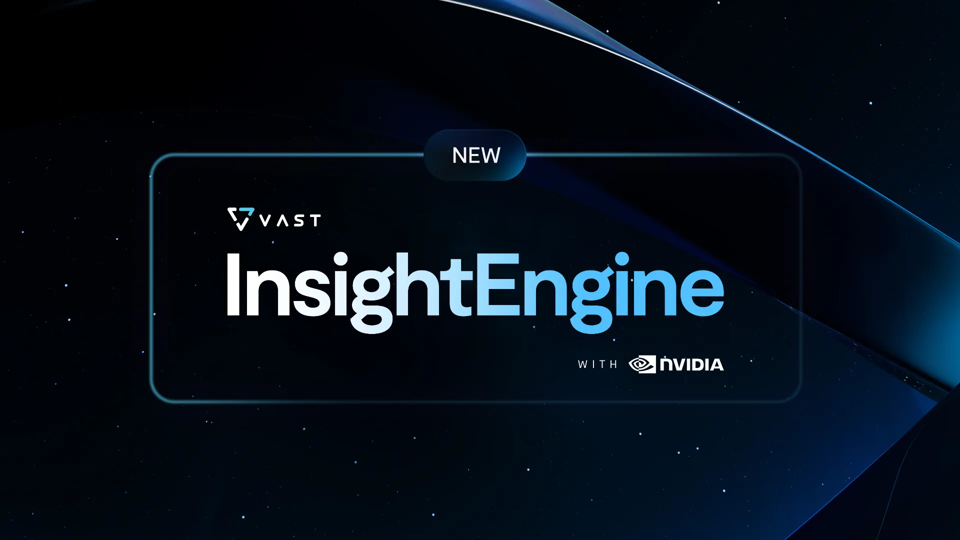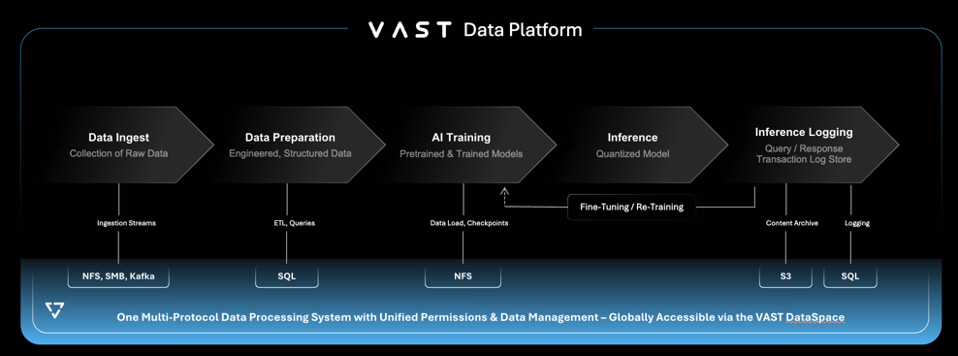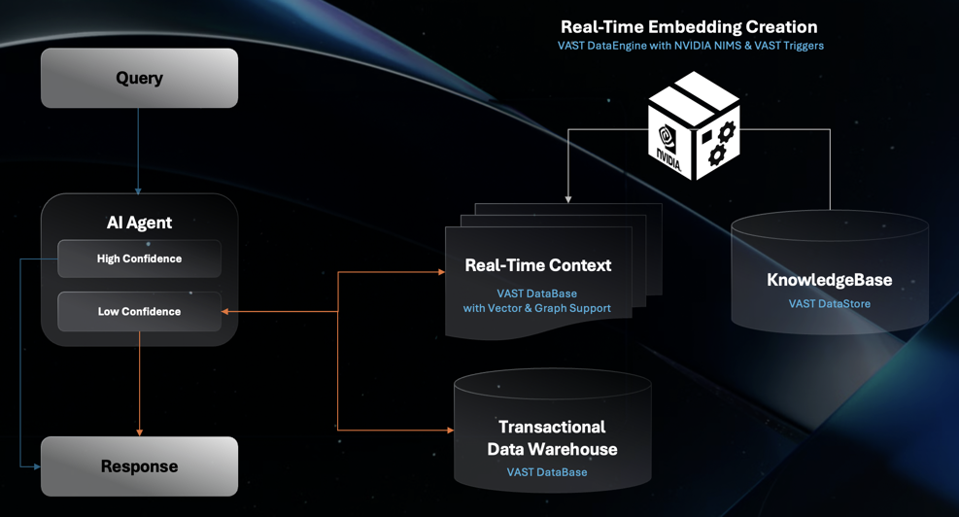
VAST Data launched its Data Platform about a year ago, aiming to unify storage, compute and data. The company’s bigger goal is to remove the complexity of connecting all of an enterprise’s data to the applications and tools that turn that data into intelligence.
In its latest move, the company and AI giant Nvidia have partnered to announce InsightEngine, which is designed to deliver real-time retrieval-augmented generation. Let’s take a deeper look at this announcement and consider what this means for enterprise IT organizations and the industry as a whole.
AI Is Complex, And Data Is The Problem
First, it’s worth revisiting the underlying problem that VAST addresses. Saying that AI is complex is not original or controversial. It’s complex for many reasons, including technical, operational and organizational aspects. One of the biggest challenges comes from the data used for AI. Data resides everywhere, from the edge to on-premises datacenters to the cloud. Data also resides in the applications that power the business—ERP, CRM, HRM and the like. Finally, data exists in many different formats, both structured (e.g., database tables) and unstructured (documents, pictures, etc.).
Here’s the long-running challenge: how does an enterprise that wants to extract value from its data do that easily? Historically, the answer has been: it doesn’t. That’s what VAST has tried to address with its Data Platform, which has resolved many of the challenges in this area through a number of components:
- DataStore: A scalable solution for storing unstructured data without data tiering—meaning that all data is “hot” and critical
- DataBase: A scalable transactional and analytical database that combines the capabilities of traditional databases, data warehouses and data lakes
- DataEngine: The intelligence that quickly takes data and makes it AI-ready through triggers and functions
- DataSpace: A global namespace that makes it simple to get to data wherever it resides across the enterprise—on the edge, in a co-lo, in the cloud or in an enterprise’s datacenter.

So to recap, the introduction of the VAST Data Platform was aimed directly at the challenge of how IT organizations can more easily collect, prepare and train large amounts of data that feed large language models for use in AI applications.
But the challenge continues to evolve. As AI ages a little, we have started to see the discussion shift from frontier models to enterprise inference. As the discussion shifts, so does the challenge of how we make this trained data work in the enterprise beyond simple chatbots and the like. How does inference work to drive business outcomes? And is RAG the answer? For the latter question, VAST would argue: not in its current state.
InsightEngine Delivers Real-Time RAG With Nvidia NIM
InsightEngine is where VAST has trained its focus to help enterprises extract full value from AI inference. Working with Nvidia, InsightEngine delivers more accurate, more contextualized responses to the queries that a user or another application may initiate. NIM (which stands for “Nvidia inference microservices”) is Nvidia’s framework that enables an enterprise to take trained data and use it more precisely and efficiently in each application.
By working with NIM, InsightEngine can create vector and graph embeddings in VAST’s DataBase product. Whenever new data is generated, vector embeddings are generated to update the database in real time. These vectors, graphs and tables are then used in RAG. The result is an implementation of RAG that is highly accurate and delivered in real time from VAST’s vector database, which can scale up to trillions of embeddings.

Depending on how inference is used, real-time RAG’s benefit may not be as critical to a specific organization. However, for mission- and business-critical applications that are driven by AI agents—and interact with other AI agents—a lack of real-time data can be a serious issue. If you think this agentic model (i.e., one in which AI agents interact with one another across the enterprise) is a little futuristic, it’s not. Or maybe more precisely put, it is futuristic—but the future is now.
How is all of this possible? VAST employs a disaggregated, share-nothing architecture. This takes a standard storage architecture and makes it broad and shallow. This removes the notion of data tiering, so essentially all data is “hot.” Because of this, InsightEngine can quickly ingest data from enterprise applications and vectorize it in the VAST DataBase. Object, file, table, graph—all of it gets stored in this transactional/analytical database for retrieval. And whenever real-time RAG is enabled, InsightEngine also fine-tunes your large language models.
Cosmos, Because It Takes A Village
The less-covered element of VAST’s announcement is arguably the most valuable to enterprise IT today. Cosmos is a community where VAST directly connects AI practitioners with AI experts. While every organization would love to hire 20 Ph.D.s to design and deploy AI across the enterprise, the reality is that AI talent is scarce—and pricey. While the VAST Data Platform and InsightEngine are intended to simplify the process of deploying and operationalizing AI, the term “simplify” is relative. For many IT organizations, it’s still going to be really hard—and the skills gap is real.
With Cosmos, IT professionals can join a forum and interact with each other and with experts to better understand best practices and work through challenges that may otherwise seem impossible to tackle. This isn’t simply connecting a user to a VAST support person; it connects them to other users facing the same challenges, along with folks from the big consulting firms and the hardware and software vendors.
Of course, communities like Cosmos are constrained by how much they are used and how well they are moderated. If this community becomes nothing but a sales vehicle for Accenture, Deloitte and others, it will quickly lose its appeal. However, there is real potential here.
Is VAST’s Offering Unique?
When VAST announced the Data Platform last year, it was the only vendor bringing such data management to storage. With InsightEngine, it has further differentiated itself. However, NetApp recently announced its storage and data management platform ONTAP with an AI engine that performs the functions of much of the AI data pipeline.
Perhaps VAST’s biggest competitor in the high-performance storage space is Weka, which has its own data platform for generative AI. Weka’s cloud-native architecture might be the closest to VAST’s, in that the company has designed its solution from the ground up for high performance.
The addition of InsightEngine with Nvidia to VAST’s architecture delivers an advantage for VAST because it expands coverage along not just the AI data pipeline but the whole AI journey, from training to inference. VAST’s customers are a Who’s Who of data- and performance-driven organizations, such as Zoom, NASA, Pixar and GPU cloud provider CoreWeave.
Implications For VAST’s Market Approach
VAST is a data management company. Though its early years were spent designing high-performance storage, that was clearly done to build a foundation for its data management play. Further, the company has successfully built out its storage and data management platforms—otherwise, it would not have a valuation of over $9 billion.
Here are two things to consider about VAST. The first is that it caters to the needs of companies with significant data management challenges—the cream of the crop, if you will. VAST will undoubtedly continue to find success in this space, but there are questions about whether its technology can successfully come downmarket to find a larger addressable market. For that matter, does VAST even want to?
The second consideration is where I imagine myself as a VAST customer. Deploying the VAST Data Platform is a deep engagement. Once I jump in, it’s not easy to move away from it. This isn’t a bad thing, but it is undoubtedly a consideration for any enterprise IT organization considering vendors to support its AI journey.
InsightEngine Plays Into VAST’s Long-Term Focus
VAST’s evolution has been fun to watch. From a storage company that took the HPC world by storm to claiming the AI OS title, it has been a bold company that hasn’t been afraid to be the first mover.
When the company introduced the Data Platform last year, conceptualizing it was a little hard. This was partly because the company was out in front of the market, talking about AI pipelines, global namespaces, DASE and DataEngine while everybody else was talking about LLMs and ChatGPT. InsightEngine brings the VAST Data Platform into sharper focus and shows how the company is making itself an integral part of the entire AI journey—from finding and preparing data to training and inference.
The one bit of advice I would leave you with is this: AI is still complex. While VAST has removed a lot of the complexity, the AI market has seen far more failures than successes to date. Look to Cosmos and other communities to engage with experts and ensure you lay down the right foundation.























































































